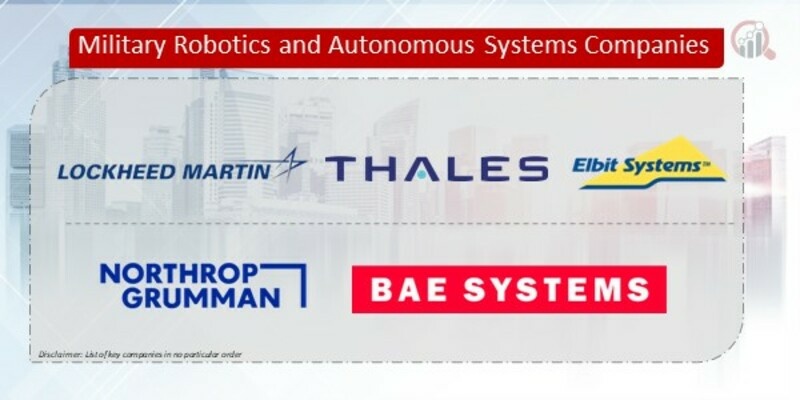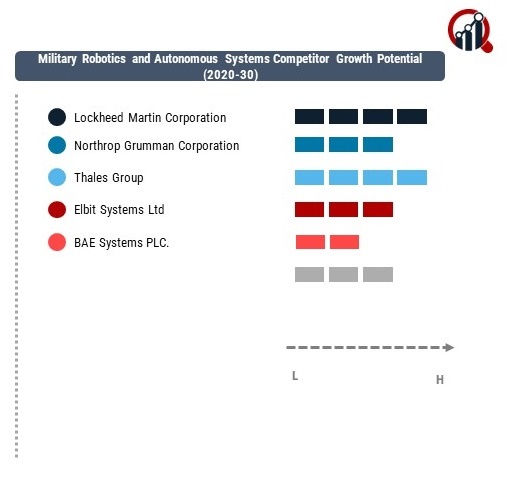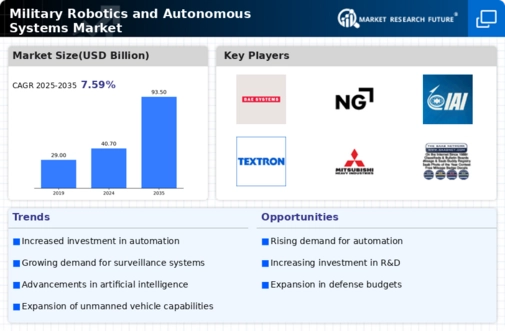Top Industry Leaders in the Military Robotics Autonomous Systems Market

Strategies Adopted: Key players in the Military Robotics Autonomous Systems Market deploy various strategies to maintain their competitive edge and capitalize on market opportunities. These strategies include:
Technological Innovation: Companies invest in research and development to advance autonomous capabilities, artificial intelligence algorithms, sensor fusion, and mission autonomy to enhance the performance, versatility, and reliability of military robotic systems.
Strategic Partnerships: Collaborations with defense agencies, research institutions, technology providers, and industry stakeholders help companies access new markets, expand their product portfolio, and leverage complementary expertise and resources to address evolving threats and requirements.
Customization and Modularity: Companies offer customizable and modular robotic systems that can be tailored to specific mission requirements, payloads, and environments, providing flexibility, scalability, and interoperability for military operators.
Global Presence: Key players focus on establishing a global footprint through subsidiaries, joint ventures, and partnerships in strategic locations to better serve their customers, comply with local regulations, and capitalize on regional defense spending and procurement opportunities.
Key Players:
Lockheed Martin Corporation
Northrop Grumman Corporation
Thales Group
Elbit Systems Ltd
and BAE Systems PLC
Factors for Market Share Analysis: Several factors contribute to the analysis of market share in the Military Robotics Autonomous Systems Market, including:
Performance and Capability: The performance, reliability, and mission effectiveness of robotic systems play a critical role in determining market share, with companies offering advanced capabilities, such as long-endurance, high-speed mobility, and multi-domain operations, gaining a competitive advantage.
Affordability and Life Cycle Costs: Affordability and life cycle costs, including acquisition, operation, and maintenance expenses, influence market share, with companies offering cost-effective solutions that deliver value over the entire product lifecycle attracting customers and winning contracts.
Customer Relationships and Support: Strong relationships with defense agencies, military end-users, and aftermarket support networks enhance market share by fostering trust, loyalty, and long-term partnerships, with companies offering responsive customer support, training, and sustainment solutions gaining a competitive edge.
Regulatory Compliance and Export Controls: Compliance with regulatory requirements, export controls, and international agreements, such as ITAR (International Traffic in Arms Regulations) and Wassenaar Arrangement, is essential for gaining market share and securing contracts in the global defense market.
New and Emerging Companies: In addition to established players, new and emerging companies are entering the Military Robotics Autonomous Systems Market, bringing innovative technologies and solutions. These companies often focus on niche segments or disruptive approaches, challenging traditional players and driving innovation in the industry. Some notable new and emerging companies in the market include:
Shield AI, Inc.
Ghost Robotics Corporation
Anduril Industries
Clearpath Robotics Inc.
Roboteam Ltd.
Milrem Robotics
FLIR Unmanned Ground Systems (Formerly Endeavor Robotics)
DroneShield Limited
Industry News and Current Investment Trends: Recent developments and investment trends in the Military Robotics Autonomous Systems Market reflect a growing emphasis on autonomy, interoperability, and swarming capabilities. Key highlights include:
Autonomy Advancements: Companies are integrating artificial intelligence (AI), machine learning (ML), and autonomy algorithms to enable unmanned systems to operate autonomously, adapt to changing environments, and collaborate with manned platforms and other unmanned assets.
Interoperability Standards: Efforts to establish interoperability standards, common data formats, and open architecture frameworks, such as JAIC (Joint All-Domain Command and Control) and JADC2 (Joint All-Domain Command and Control), are driving collaboration and integration across military robotic systems.
Swarming Technology: Advancements in swarming technology enable unmanned systems to operate collaboratively in coordinated formations, performing distributed sensing, communication relay, and collective decision-making tasks to enhance situational awareness and mission effectiveness.
Overall Competitive Scenario: The Military Robotics Autonomous Systems Market is highly competitive, characterized by technological innovation, strategic partnerships, and regulatory compliance. Established players leverage their experience, scale, and global reach to maintain market leadership, while new entrants disrupt the market with novel technologies and agile strategies. As the demand for unmanned systems continues to grow, companies that focus on autonomy, interoperability, and affordability will thrive in the competitive landscape of the Military Robotics Autonomous Systems Market.










